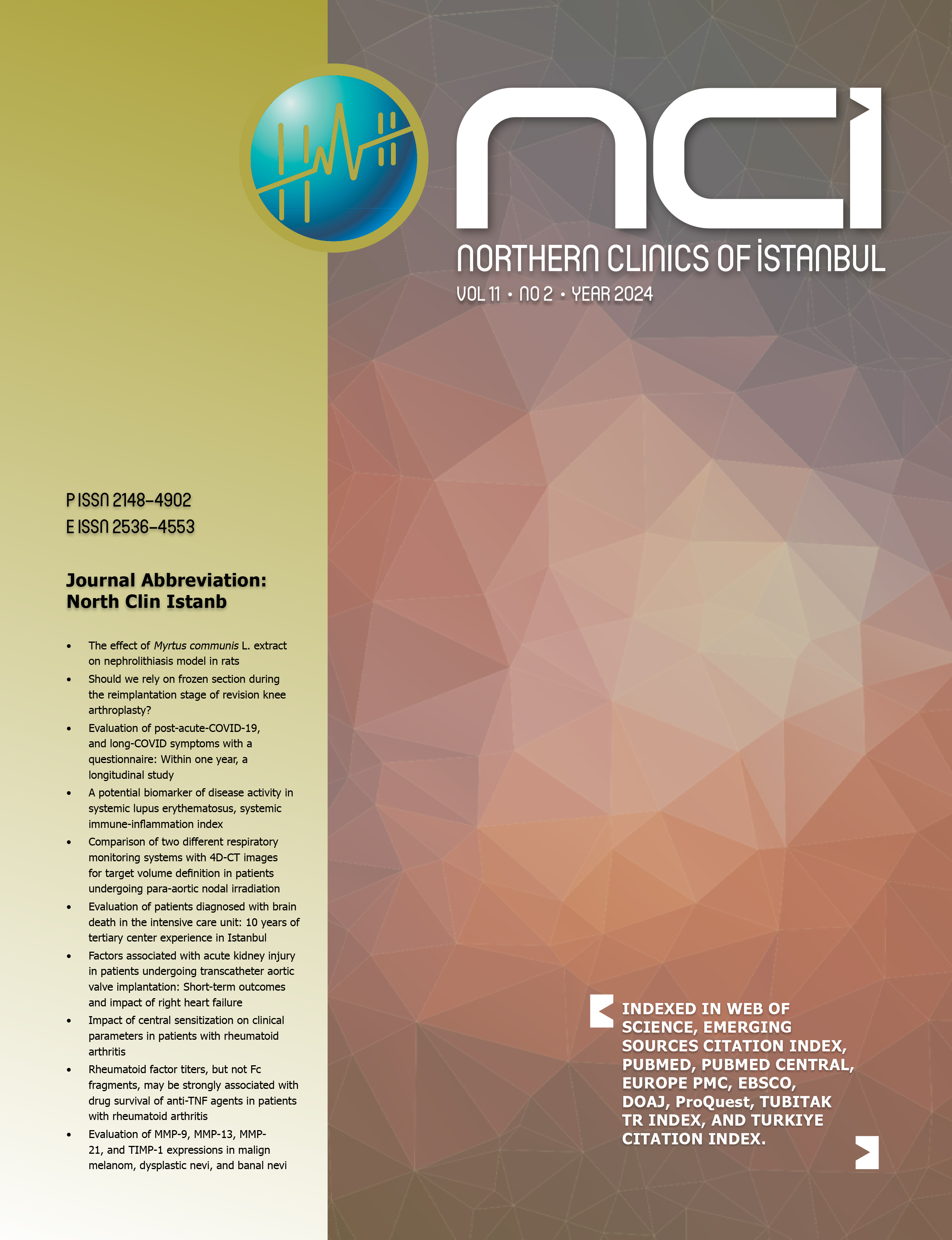Evaluation of rescue techniques following failed laryngoscopy: A multicenter prospective observational study
Kemal Tolga Saracoglu1, Mehmet Yilmaz2, Ayse Zeynep Turan2, Ayten Saracoglu3, Alparslan Kus4, Volkan Alparslan4, Ozlem Deligoz5, Zuhal Aykac3, Osman Ekinci51Department of Anesthesiology and Intensive Care, Health Sciences University, Kartal Dr. Lutfi Kirdar Training and Research Hospital, Istanbul, Turkiye2Department of Anesthesiology and Intensive Care, Health Sciences University, Derince Training and Research Hospital, Kocaeli, Turkiye
3Department of Anesthesiology and Intensive Care, Marmara University, Pendik Training and Research Hospital, Istanbul, Turkiye
4Department of Anesthesiology and Intensive Care, Kocaeli University Faculty of Medicine, Kocaeli, Turkiye
5Department of Anesthesiology and Intensive Care, Health Sciences University, Haydarpasa Numune Training and Research Hospital, Istanbul Turkiye
OBJECTIVE: The Fourth National Audit Project revealed that severe airway complications occur in the frequency of 1/22,000. Various rescue techniques were recommended in difficult airway guidelines. This study aims to evaluate the rescue techniques following failed direct laryngoscopy and analyze the success rates and potential complications during difficult airway management.
METHODS: This was a multicenter and prospective observational study carried out in four referral centers. Four academic university hospitals using fiberoptic bronchoscopy and videolaryngoscopy in their daily practice were included in the study. Patients undergoing general anesthesia with anticipated or unanticipated difficult intubation were enrolled. The preferred rescue technique and the attempts for both direct and indirect laryngoscopies were recorded.
RESULTS: At the mean age of 46.58±21.19 years, 92 patients were analyzed. The most common rescue technique was videolaryngoscopy following failed direct laryngoscopy. Glidescope was the most preferred videolaryngoscope. Anesthesia residents performed most of the first tracheal intubation attempts, whereas anesthesia specialists performed the second attempts at all centers. The experience of the first performer as a resident was significantly higher in the anticipated difficult airway group (4.0±5.5 years) (p=0.045). The number of attempts with the first rescue technique was 2.0±2.0 and 1.0±1.0 in the unanticipated difficult airway and anticipated difficult airway groups, respectively (p=0.004).
CONCLUSION: Videolaryngoscopy was a more commonly preferred technique for both anticipated and unanticipated difficult intubations. Glidescope was the most used rescue device in difficult intubations after failed direct laryngoscopy, with a high success rate.
Keywords: Airway management, anesthesia, rescue technique, tracheal intubation.
Başarısız laringoskopi sonrasi kurtarma tekniklerinin değerlendirilmesi: Çok merkezli prospektif gözlemsel çalışma
Kemal Tolga Saracoglu1, Mehmet Yilmaz2, Ayse Zeynep Turan2, Ayten Saracoglu3, Alparslan Kus4, Volkan Alparslan4, Ozlem Deligoz5, Zuhal Aykac3, Osman Ekinci51Sağlık Bilimleri Üniversitesi Kartal Dr. Lütfi Kırdar Eğitim ve Araştırma Hastanesi, Anesteziyoloji ve Yoğun Bakım Kliniği, İstanbul2Sağlık Bilimleri Üniversitesi Derince Eğitim ve Araştırma Hastanesi, Anesteziyoloji ve Yoğun Bakım Kliniği, Kocaeli
3Marmara Üniversitesi Pendik Eğitim ve Araştırma Hastanesi, Anesteziyoloji ve Yoğun Bakım Anabilim Dalı, İstanbul
4Kocaeli Üniversitesi Tıp Fakültesi, Anesteziyoloji ve Yoğun Bakım Anabilim Dalı, Kocaeli
5Sağlık Bilimleri Üniversitesi Haydarpaşa Numune Eğitim ve Araştırma Hastanesi, Anesteziyoloji ve Yoğun Bakım Kliniği, İstanbul
Giriş: 4. National Audit Projectte ciddi havayolu komplikasyonu insidansı 1/22.000 olarak bildirilmektedir. Zor havayolu rehberlerinde zor entübasyon durumunda çeşitli kurtarıcı yöntemler önerilmektedir. Bu çalışmamızda başarısız direkt laringoskopi sonrası kurtarıcı tekniklerin başarısını ve zor havayolu durumunda potansiyel komplikasyonlarını analiz etmeyi amaçladık.
Materyal ve metot: Çalışma çok merkezli, prospektif, gözlemsel bir çalışma olarak planlandı. Çalışmaya günlük ameliyathane rutininde fiberoptik bronkosopi ve videolaringoskopi kullanan dört üniversite hastanesi dahil edildi. Genel anestezi altında operasyona alınan hastalardan, beklenen ya da beklenmeyen zor entübasyon olguları çalışmaya dahil edildi. Tercih edilen kurtarıcı teknikler, direkt ve indirekt laringoskopi girişimleri kayıt altına alındı.
Bulgular: Ortalama yaşı 46.58 ± 21.19 olan 92 hasta çalışmaya dahil edildi. En yaygın kullanılan kurtarıcı yöntem videolaringoskopi, ve en çok tercih edilen videolaringoskop glidescope olarak tespit edildi. Tüm merkezlerde ilk laringoskopi girişimi asistanlar tarafından ve ikinci girişim anestezi uzmanları tarafından uygulandı. Öngörülen zor entübasyon grubunda, ilk direkt laringoskopiyi uygulayan asistanların kıdemi, istatistiksel olarak anlamlı derecede yüksekti(4.0 ± 5.5 years) (p=0.045). İlk kurtarıcı teknik için girişim sayısı, öngörülemeyen zor entübasyon grubunda ve öngörülen zor entübasyon grubunda sırasıyla 2.0 ± 2.0 ve 1.0 ± 1.0 olarak tespit edildi. (p=0.004).
Tartışma: Videolaringoskopun öngörülen ve öngörülemeyen zor entübasyon olgularında en yaygın tercih edilen kurtarıcı teknik olmuştur. Glidescope ise hem öngörülen hem öngörülemeyen zor entübasyon olgularında yüksek başarı oranı ile en çok tercih edilen videolaringoskop olmuştur. (NCI-2021-5-9/R1)
Anahtar Kelimeler: Havayolu yönetimi, anestezi, kurtarıcı teknikler, trakeal entübasyon.
Manuscript Language: English





















